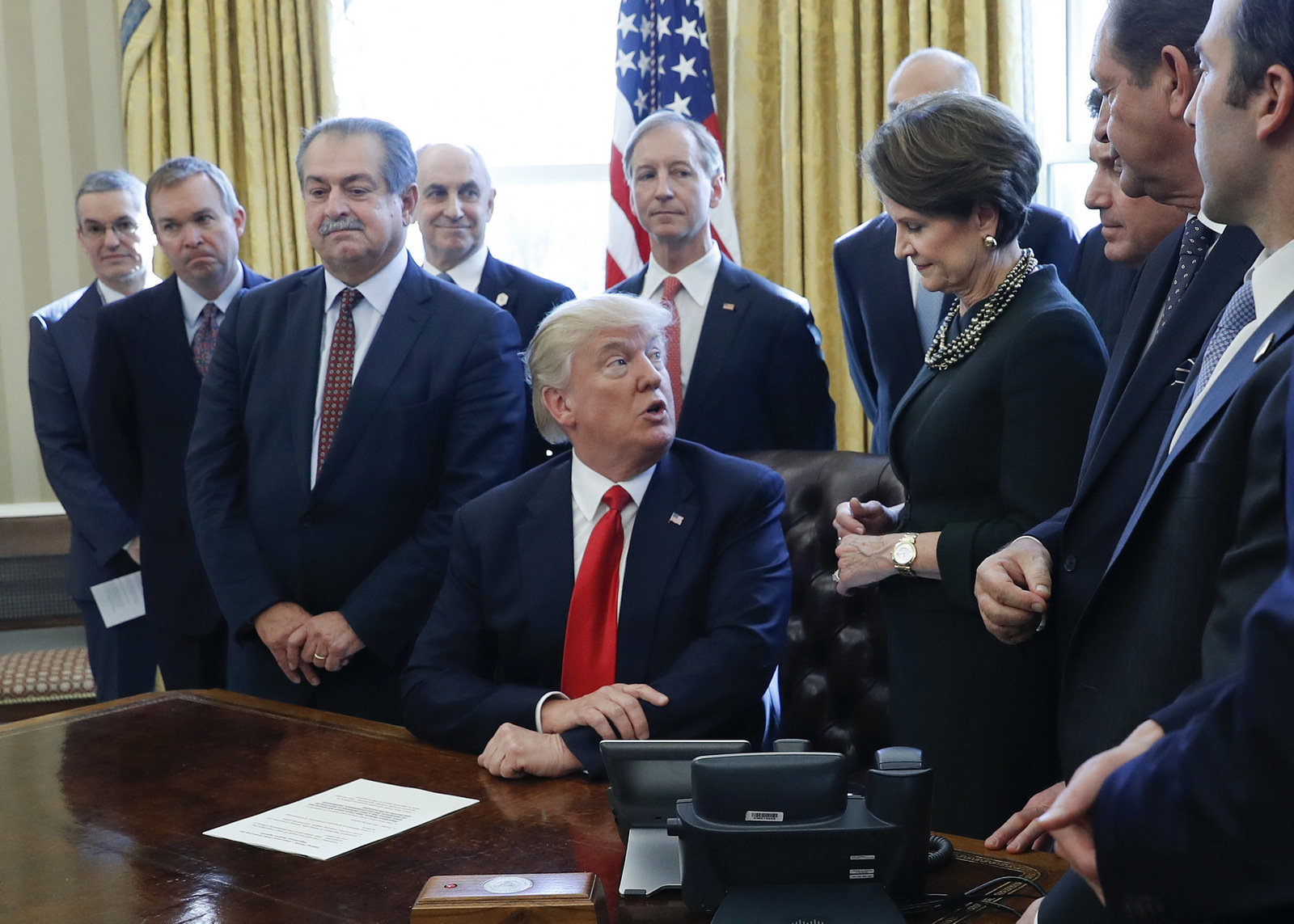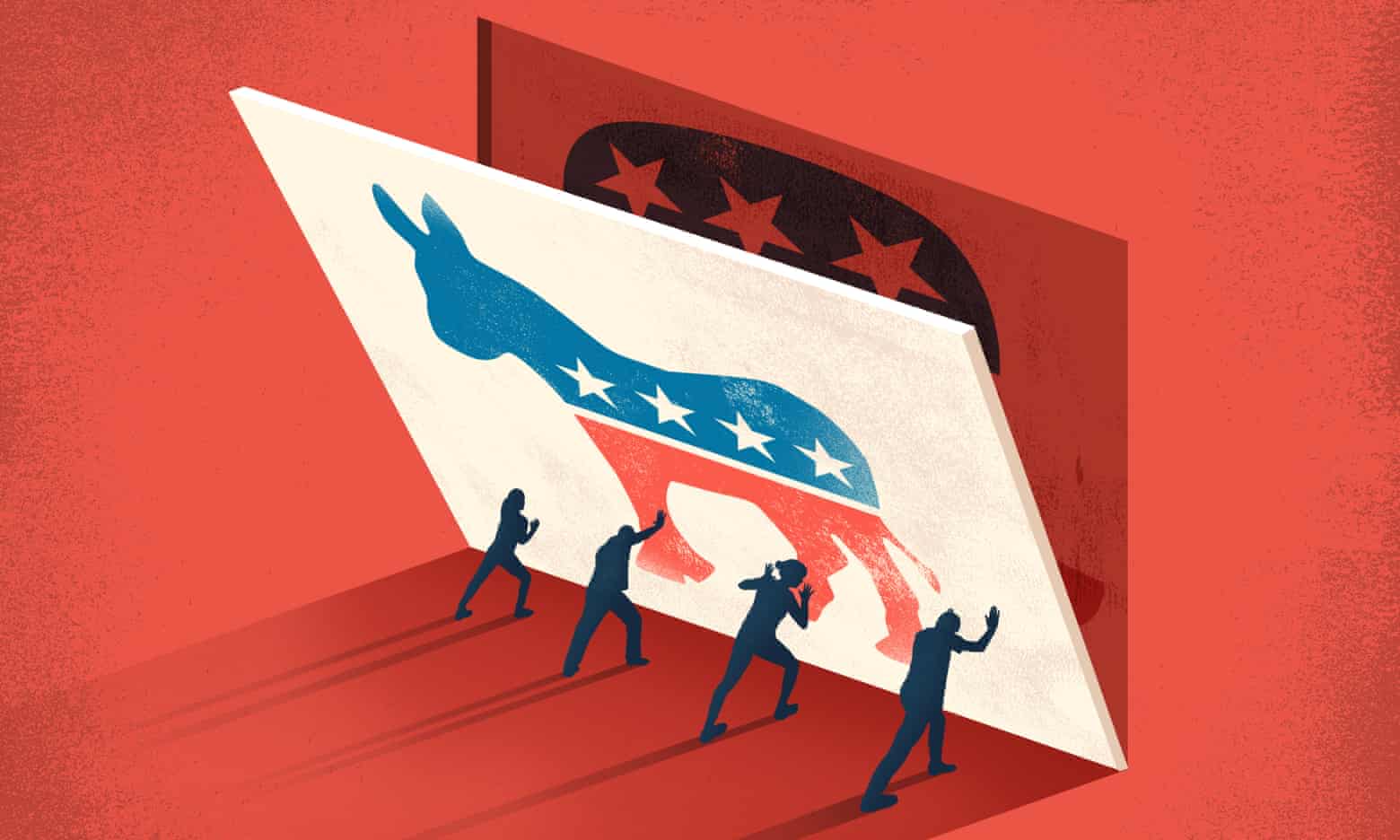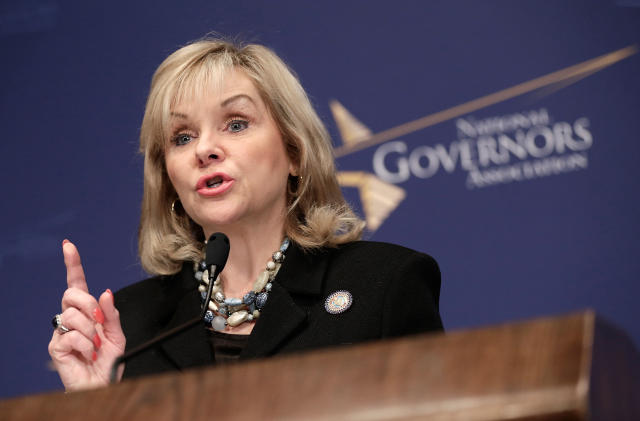Mint Press News
The Art of the Arms Deal: Trump is Peddling Arms as If There Were No Tomorrow.
Donald Trump has headed down a well-traveled arms superhighway, partnering with the likes of Lockheed Martin to sell weapons to dictatorships and repressive regimes that often fuel instability, war, and terrorism.
By William D. Hartung April 2, 2018
 President Donald Trump shows a chart highlighting arms sales to Saudi Arabia during a meeting with Saudi Crown Prince Mohammed bin Salman in the Oval Office of the White House, Tuesday, March 20, 2018, in Washington. (AP/Evan Vucci)
President Donald Trump shows a chart highlighting arms sales to Saudi Arabia during a meeting with Saudi Crown Prince Mohammed bin Salman in the Oval Office of the White House, Tuesday, March 20, 2018, in Washington. (AP/Evan Vucci)
It’s one of those stories of the century that somehow never gets treated that way. For an astounding 25 of the past 26 years, the United States has been the leading arms dealer on the planet, at some moments in near monopolistic fashion. Its major weapons-producers, including Boeing, Raytheon, and Lockheed Martin, regularly pour the latest in high-tech arms and munitions into the most explosive areas of the planet with ample assistance from the Pentagon. In recent years, the bulk of those arms have gone to the Greater Middle East. Donald Trump is only the latest American president to preside over a global arms sales bonanza. With remarkable enthusiasm, he’s appointed himself America’s number one weapons salesman and he couldn’t be prouder of the job he’s doing.
Earlier this month, for instance, on the very day Congress was debating whether to end U.S. support for Saudi Arabia’s brutal war in Yemen, Trump engaged in one of his favorite presidential activities: bragging about the economic benefits of the American arms sales he’s been promoting. He was joined in his moment of braggadocio by Saudi Crown Prince Mohammed bin Salman, the chief architect of that war. That grim conflict has killed thousands of civilians through indiscriminate air strikes, while putting millions at risk of death from famine, cholera, and other “natural” disasters caused at least in part by a Saudi-led blockade of that country’s ports.
That Washington-enabled humanitarian crisis provided the backdrop for the Senate’s consideration of a bill co-sponsored by Vermont independent Senator Bernie Sanders, Utah Republican Senator Mike Lee, and Connecticut Democratic Senator Chris Murphy. It was aimed at ending U.S. mid-air refueling of Saudi war planes and Washington’s additional assistance for the Saudi war effort (at least until the war is explicitly authorized by Congress). The bill generated a vigorous debate. In the end, on an issue that wouldn’t have even come to the floor two years ago, an unprecedented 44 senators voted to halt this country’s support for the Saudi war effort. The bill nonetheless went down to defeat and the suffering in Yemen continues.
Debate about the merits of that brutal war was, however, the last thing on the mind of a president who views his bear-hug embrace of the Saudi regime as a straightforward business proposition. He’s so enthusiastic about selling arms to Riyadh that he even brought his very own prop to the White House meeting with bin Salman: a U.S. map highlighting which of the 50 states would benefit most from pending weapons sales to the prince’s country.
You undoubtedly won’t be surprised to learn that Michigan, Ohio, and Florida, the three crucial swing states in the 2016 presidential election, were specially highlighted. His latest stunt only underscored a simple fact of his presidency: Trump’s arms sales are meant to promote pork-barrel politics, while pumping up the profits of U.S. weapons manufacturers. As for human rights or human lives, who cares?
To be fair, Donald Trump is hardly the first American president to make it his business to aggressively promote weapons exports. Though seldom a highlighted part of his presidency, Barack Obama proved to be a weapons salesman par excellence. He made more arms offers in his two terms in office than any U.S. president since World War II, including an astounding $115 billion in weapons deals with Saudi Arabia. For the tiny group of us who follow such things, that map of Trump’s only underscored a familiar reality.
On it, in addition to the map linking U.S. jobs and arms transfers to the Saudis, were little boxes that highlighted four specific weapons sales worth tens of billions of dollars. Three of those that included the THAAD missile defense system, C-130 transport planes, P-8 anti-submarine warfare planes, and Bradley armored vehicles were, in fact, completed during the Obama years. So much for Donald Trump’s claim to be a deal maker the likes of which we’ve never seen before. You might, in fact, say that the truest arms race these days is between American presidents, not the United States and other countries. Not only has the U.S. been the world’s top arms exporting nation throughout this century, but last year it sold one and a half times as much weaponry as its closest rival, Russia.
Embracing Lockheed Martin
 President Donald Trump looks over to Lockheed Martin Chairwoman, President and CEO Marillyn Hewson, right, before signing an executive order in the Oval Office of the White House in Washington, Feb. 24, 2017.(AP/Pablo Martinez Monsivais)
President Donald Trump looks over to Lockheed Martin Chairwoman, President and CEO Marillyn Hewson, right, before signing an executive order in the Oval Office of the White House in Washington, Feb. 24, 2017.(AP/Pablo Martinez Monsivais)
It’s worth noting that three of those four Saudi deals involved weapons made by Lockheed Martin. Admittedly, Trump’s relationship with Lockheed got off to a rocky start in December 2016 when he tweeted his displeasure over the cost of that company’s F-35 combat aircraft, the most expensive weapons program ever undertaken by the Pentagon. Since then, however, relations between the nation’s largest defense contractor and America’s most self-involved president have warmed considerably.
Before Trump’s May 2017 visit to Saudi Arabia, his son-in-law, Jared Kusher, new best buddy to Mohammed bin Salman, was put in charge of cobbling together a smoke-and-mirrors, wildly exaggerated $100 billion-plus arms package that Trump could announce in Riyadh. What Kushner needed was a list of sales or potential sales that his father-in-law could boast about (even if many of the deals had been made by Obama). So he called Lockheed Martin CEO Marillyn Hewson to ask if she could cut the price of a THAAD anti-missile system that the administration wanted to include in the package. She agreed and the $15 billion THAAD deal — still a huge price tag and the most lucrative sale to the Saudis made by the Trump administration — went forward. To sweeten the pot for the Saudi royals, the Pentagon even waived a $3.5 billion fee normally required by law and designed to reimburse the Treasury for the cost to American taxpayers of developing such a major weapons system. General Joseph Rixey, until recently the director of the Pentagon’s Defense Security Cooperation Agency, which granted that waiver, has since gone directly through Washington’s revolving door and been hired by — you guessed it — Lockheed Martin.
In addition, former Lockheed Martin executive John Rood is now the Trump administration’s undersecretary of defense for policy, where one of his responsibilities will be to weigh in on… don’t be shocked!… major arms deals. In his confirmation hearings, Rood refused to say that he would recuse himself from transactions involving his former employer, for which he was denounced by Senators John McCain and Elizabeth Warren. As Warrenasserted in a speech opposing Rood’s appointment,
“No taxpayer should have to wonder whether the top policy-makers at the Pentagon are pushing defense products and foreign military sales for reasons other than the protection of the United States of America… No American should have to wonder whether the Defense Department is acting to protect the national interests of our nation or the financial interests of the five giant defense contractors.”
Still, most senators were unfazed and Rood’s nomination sailed through that body by a vote of 81 to 7. He is now positioned to help smooth the way for any Lockheed Martin deal that might meet with a discouraging word from the Pentagon or State Department officials charged with vetting foreign arms sales.
Arming the Planet
 Benjamin Netanyahu reaches to an American-made F-35 fighter jet at an unveiling ceremony in Nevatim Air Force base, Southern Israel. (AP/Ariel Schalit)
Benjamin Netanyahu reaches to an American-made F-35 fighter jet at an unveiling ceremony in Nevatim Air Force base, Southern Israel. (AP/Ariel Schalit)
Though Saudi Arabia may be the largest recipient of U.S. arms on the planet, it’s anything but Washington’s only customer. According to the Pentagon’s annual tally of major agreements under the Foreign Military Sales program, the most significant channel for U.S. arms exports, Washington entered into formal agreements to sell weaponry to 130 nations in 2016 (the most recent year for which full data is available). According to a recent report from the Cato Institute, between 2002 and 2016 the United States delivered weaponry to 167 countries — more than 85% of the nations on the planet. The Cato report also notes that, between 1981 and 2010, Washington supplied some form of weaponry to 59% of all nations engaged in high-level conflicts.
In short, Donald Trump has headed down a well-traveled arms superhighway. Every president since Richard Nixon has taken that same road and, in 2010, the Obama administration managed to rack up a record $102 billion in foreign arms offers. In a recent report I wrote for the Security Assistance Monitor at the Center for International Policy, I documented more than $82 billion in arms offers by the Trump administration in 2017 alone, which actually represented a slight increase from the $76 billion in offers made during President Obama’s final year. It was, however, far lower than that 2010 figure, $60 billion of which came from Saudi deals for F-15 combat aircraft, Apache attack helicopters, transport aircraft, and armored vehicles, as well as guns and ammunition.
There have nonetheless been some differences in the approaches of the two administrations in the area of human rights. Under pressure from human rights groups, the Obama administration did, in the end, suspend sales of aircraft to Bahrain and Nigeria, both of whose militaries were significant human rights violators, and also a $1 billion-plus deal for precision-guided bombs to Saudi Arabia. That Saudi suspension represented the first concrete action by the Obama administration to express displeasure with Riyadh’s indiscriminate bombing campaign in Yemen. Conducted largely with U.S. and British supplied aircraft, bombs, and missiles, it has included strikes against hospitals, marketplaces, water treatment facilities, and even a funeral. In keeping with his focus on jobs to the exclusion of humanitarian concerns, Trump reversed all three of the Obama suspensions shortly after taking office.
Fueling Terrorism and Instability
 A well-equipped Syrian rebel using a US-made BGM-71 TOW against the Syrian Arab Army. (YouTube Screenshot)
A well-equipped Syrian rebel using a US-made BGM-71 TOW against the Syrian Arab Army. (YouTube Screenshot)
In fact, selling weapons to dictatorships and repressive regimes often fuels instability, war, and terrorism, as the American war on terror has vividly demonstrated for the last nearly 17 years. U.S.-supplied arms also have a nasty habit of ending up in the hands of America’s adversaries. At the height of the U.S. intervention in Iraq, for instance, that country’s armed forces lost track of hundreds of thousands of rifles, many of which made their way into the hands of forces resisting the U.S. occupation.
In a similar fashion, when Islamic State militants swept into Iraq in 2014, the Iraqi security forces abandoned billions of dollars worth of American equipment, from small arms to military trucks and armored vehicles. ISIS promptly put them to use against U.S. advisers and the Iraqi security forces as well as tens of thousands of Iraqi civilians. The Taliban, too, has gotten its hands on substantial quantities of U.S. weaponry, either on the battlefield or by buying them at cut-rate, black market prices from corrupt members of the Afghan security forces.
In northern Syria, two U.S.-armed groups are now fighting each other. Turkish forces are facing off against Syrian Kurdish militias that have been among the most effective anti-ISIS fighters and there is even an ongoing risk that U.S. and Turkish forces, NATO allies, may find themselves in direct combat with each other. Far from giving Washington influence over key allies or improving their combat effectiveness, U.S. arms and training often simply spur further conflict and chaos to the detriment of the security of the United States, not to speak of the peace of the world.
In the grim and devolving conflict in Yemen, for instance, all sides possess at least some U.S. weaponry. Saudi Arabia is, of course, the top U.S. arms client and its forces are a catalogue of American weaponry, from planes and anti-tank missiles to cluster bombs, but hundreds of millions of dollars in U.S. military aid were also provided to the forces of Yemeni autocrat Ali Abdullah Saleh during his 30 years of rule before he was driven from power in 2012. Later, however, he joined forces with the Houthi rebels against the Saudi-led intervention, taking large parts of the Yemeni armed forces — and their U.S.-supplied weapons — with him. (He would himself be assassinated by Houthi forces late last year after a falling out.)
Trump’s Plan: Make It Easier on Arms Makers
 Lockheed Martin CEO Marillyn Hewson participates in a signing ceremony between President Donald Trump and Saudi King Salam, May 20, 2017, in Riyadh. (AP/Evan Vucci)
Lockheed Martin CEO Marillyn Hewson participates in a signing ceremony between President Donald Trump and Saudi King Salam, May 20, 2017, in Riyadh. (AP/Evan Vucci)
The Trump administration is poised to release a new policy directive on global arms transfers. A report by Politico, based on interviews with sources at the State Department and a National Security Council (NSC) official, suggests that it will seek to further streamline the process of approving arms sales, in part by increasing the already extensive role of U.S. government personnel in promoting such exports. It will also remove what a National Security Council statement has described as “unreasonable constraints on the ability of our companies to compete.” In keeping with that priority, according to the NSC official, “the administration is intent on ensuring that U.S. industry has every advantage in the global marketplace.”
In January, a Reuters article confirmed this approach, reporting that the forthcoming directive would emphasize arms-sales promotion by U.S. diplomats and other overseas personnel. As one administration official told Reuters, “We want to see those guys, the commercial and military attaches, unfettered to be salesmen for this stuff, to be promoters.”
The Trump administration is also expected to move forward with a plan, stalled as the Obama years ended, to ease controls on the export of U.S. firearms. Gun exports now licensed and scrutinized by the State Department would instead be put under the far-less-stringent jurisdiction of the Commerce Department. Some firearms could then be exported to allies without even a license, reducing the government’s ability to prevent them from reaching criminal networks or the security forces of potential adversaries.
In September 2017, Democratic senators Ben Cardin, Dianne Feinstein, and Patrick Leahy sent a letter to then-Secretary of State Rex Tillerson raising concerns about such a change. As they wrote, “Combat firearms and ammunition are uniquely lethal; they are easily spread and easily modified, and are the primary means of injury, death and destruction in civil and military conflicts throughout the world. As such they should be subjected to more — not less — rigorous export controls and oversight.”
If Trump’s vision of an all-arms-sales-all-the-time foreign policy is realized, he may scale the weapons-dealing heights reached by the Obama administration. As Washington’s arms-dealer-in-chief, he might indeed succeed in selling American weaponry as if there were no tomorrow. Given the known human costs of unbridled arms trafficking, however, such a presidency would also ensure that whatever tomorrow finally arrived would prove far worse than today, unless of course you happen to be a major U.S. arms maker.
William D. Hartung, a TomDispatch regular, is the director of the Arms and Security Project at the Center for International Policy and the author of “Trends in Major U.S. Arms Sales in 2017: A Comparison of the Obama and Trump Administrations,” Security Assistance Monitor, March 2018.
Follow TomDispatch, where this article first appeared on Twitter and join them on Facebook. Check out the newest Dispatch Book, Alfred McCoy’s In the Shadows of the American Century: The Rise and Decline of U.S. Global Power, as well as John Dower’s The Violent American Century: War and Terror Since World War II, John Feffer’s dystopian novel Splinterlands, Nick Turse’s Next Time They’ll Come to Count the Dead, and Tom Engelhardt’s Shadow Government: Surveillance, Secret Wars, and a Global Security State in a Single-Superpower World.

 Photographer: Lars Hagber/Alamy
Photographer: Lars Hagber/Alamy FILE PHOTO: EPA Administrator Scott Pruitt speaks during a meeting held by U.S. President Donald Trump on infrastructure at the White House in Washington,…Kevin Lamarque
FILE PHOTO: EPA Administrator Scott Pruitt speaks during a meeting held by U.S. President Donald Trump on infrastructure at the White House in Washington,…Kevin Lamarque Can the Democrats lead a democratic revival? Illustration: Rob Dobi
Can the Democrats lead a democratic revival? Illustration: Rob Dobi Barbara Ehrenreich: ‘Friends berate me for my heavy use of butter.’ Photograph: Stephen Voss for the Guardian
Barbara Ehrenreich: ‘Friends berate me for my heavy use of butter.’ Photograph: Stephen Voss for the Guardian Photograph: Stephen Voss for the Guardian
Photograph: Stephen Voss for the Guardian
 Environmental Protection Agency Administrator Scott Pruitt’s protective detail broke down the door at the
Environmental Protection Agency Administrator Scott Pruitt’s protective detail broke down the door at the 

 After much research and soul-searching, they decided to accept Siemon’s offer and started the transition process. It helped that his cousin Dan had transitioned one of his farms to organic not long before and that generations of his family before him had run pasture-based dairies.
After much research and soul-searching, they decided to accept Siemon’s offer and started the transition process. It helped that his cousin Dan had transitioned one of his farms to organic not long before and that generations of his family before him had run pasture-based dairies. Scientific research seems to bear out his hypothesis. A
Scientific research seems to bear out his hypothesis. A 
Lebowsky Dude: Scott Pruitt in the EPA is a scandal, republicans absolutely violated their pledges to this country by confirming him, and every single day this cretin remains in the government is a bad day…